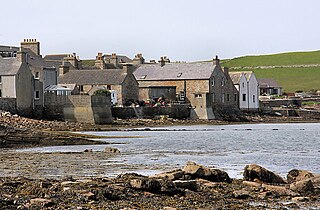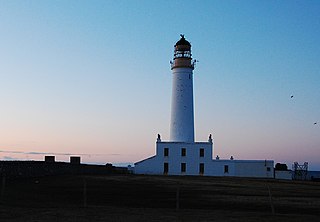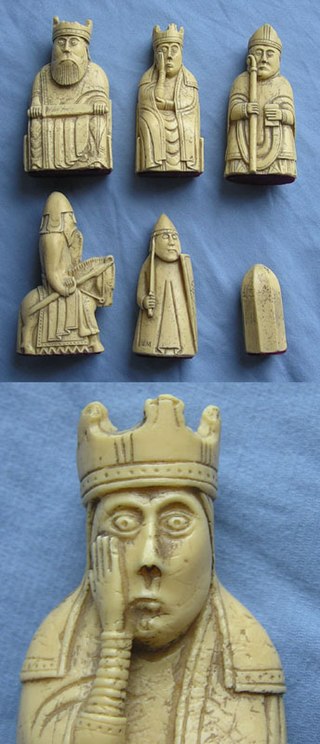
The Orkneyinga saga is a narrative of the history of the Orkney and Shetland islands and their relationship with other local polities, particularly Norway and Scotland. The saga has "no parallel in the social and literary record of Scotland" and is "the only medieval chronicle to have Orkney as the central place of action". The main focus of the work is the line of jarls who ruled the Earldom of Orkney, which constituted the Norðreyjar or Northern Isles of Orkney and Shetland and there are frequent references to both archipelagoes throughout.
Rognvald Eysteinsson was the founding Jarl of Møre in Norway, and a close relative and ally of Harald Fairhair, the earliest known King of Norway. In the Norse language he is known as Rǫgnvaldr Eysteinsson (Mǿrajarl) and in modern Norwegian as Ragnvald Mørejarl. He is sometimes referred to with bynames that may be translated into modern English as "Rognvald the Wise" or "Rognvald the Powerful".

Earl of Orkney, historically Jarl of Orkney, is a title of nobility encompassing the archipelagoes of Orkney and Shetland, which comprise the Northern Isles of Scotland. Originally founded by Norse invaders, the status of the rulers of the Northern Isles as Norwegian vassals was formalised in 1195. Although the Old Norse term jarl is etymologically related to "earl", and the jarls were succeeded by earls in the late 15th century, a Norwegian jarl is not the same thing. In the Norse context the distinction between jarls and kings did not become significant until the late 11th century and the early jarls would therefore have had considerable independence of action until that time. The position of Jarl of Orkney was eventually the most senior rank in medieval Norway except for the king himself.

Bressay is a populated island in the Shetland archipelago of Scotland.

South Ronaldsay is one of the Orkney Islands off the north coast of Scotland. It is linked to the Orkney Mainland by the Churchill Barriers, running via Burray, Glimps Holm and Lamb Holm.

Auskerry is a small island in eastern Orkney, Scotland. It lies in the North Sea south of Stronsay and has a lighthouse, completed in 1866.

Papa Stronsay is a small island in Orkney, Scotland, lying north east of Stronsay. It is 74 hectares in size, and 13 metres (43 ft) above sea level at its highest point. After being largely abandoned, the island was bought at the end of the 20th century by traditionalist Catholic monks of the Sons of the Most Holy Redeemer, who operate a monastery and farm there.
Einarr Rognvaldarson, often referred to by his byname Torf-Einarr, was one of the Norse earls of Orkney. The son of the Norse jarl Rognvald Eysteinsson and a concubine, his rise to power is related in sagas which apparently draw on verses of Einarr's own composition for inspiration. After battling for control of the Northern Isles of Scotland and a struggle with Norwegian royalty, Einarr founded a dynasty which retained control of the islands for centuries after his death.
Thorfinn Torf-Einarsson also known as Thorfinn Skull-splitter was a 10th-century Earl of Orkney. He appears in the Orkneyinga saga and briefly in St Olaf's Saga, as incorporated into the Heimskringla. These stories were first written down in Iceland in the early 13th century and much of the information they contain is "hard to corroborate".

The Earldom of Orkney was a Norse territory ruled by the earls of Orkney from the ninth century until 1472. It was founded during the Viking Age by Viking raiders and settlers from Scandinavia. In the ninth and tenth centuries it covered the Northern Isles (Norðreyjar) of Orkney and Shetland, as well as Caithness and Sutherland on the mainland. It was a dependent territory of the Kingdom of Norway until 1472, when it was absorbed into the Kingdom of Scotland. Originally, the title of Jarl or Earl of Orkney was heritable.
Sigurd Hlodvirsson, popularly known as Sigurd the Stout from the Old Norse Sigurðr digri, was an Earl of Orkney. The main sources for his life are the Norse Sagas, which were first written down some two centuries or more after his death. These engaging stories must therefore be treated with caution rather than as reliable historical documents.

Rögnvald Kali Kolsson, also known as Saint Ronald of Orkney, was a Norwegian earl of Orkney who came to be regarded as a Christian saint. Two of the Orkney Islands are named after Rögnvald, namely North Ronaldsay and South Ronaldsay.

Harald Maddadsson was Earl of Orkney and Mormaer of Caithness from 1139 until 1206. He was the son of Matad, Mormaer of Atholl, and Margaret, daughter of Earl Haakon Paulsson of Orkney. Of mixed Norse and Gaelic blood, and a descendant of Scots kings, he was a significant figure in northern Scotland, and played a prominent part in Scottish politics of the twelfth century. The Orkneyinga Saga names him one of the three most powerful Earls of Orkney along with Sigurd Eysteinsson and Thorfinn Sigurdsson.

Sigurd Eysteinsson, or Sigurd the Mighty, was the second Earl of Orkney—a title bequeathed to Sigurd by his brother Rognvald Eysteinsson. A son of Eystein Glumra, Sigurd was a leader in the Viking conquest of what is now northern Scotland.
Tarbat Ness is headland that lies at the end of the Tarbat peninsula in Easter Ross, Scotland. The name is from the Gaelic tairbeart meaning "isthmus" and the Old Norse ness, meaning "headland". It lies at the south of the entrance to the Dornoch Firth.

Helliar Holm is an uninhabited island off the coast of Shapinsay in the Orkney Islands, Scotland. It is home to a 42-foot-tall (13 m) lighthouse, which was built in 1893 and automated in 1967. It is a tidal island that used to be connected to Shapinsay. It is still possible to walk across from the mainland during very low tides.

The Earls of Møre were a dynasty of powerful noblemen in Norway dating to the unification of Norway in the 9th century. The first earl of Møre was Rognvald Eysteinsson, a close friend and ally of King Harald I of Norway. He is called by the byname Rognvald Mørejarl in the Heimskringla and Orkneyinga saga.
Halfdan Long-Leg was a Viking-Age warrior who lived in the latter half of the 9th century. He was the son of King Harald Fairhair and a Sami woman named Snæfrithr Svásadottir.
Thórir 'the Silent' Rǫgnvaldsson was a ninth-century Viking and the second Jarl of Møre.

North Ronaldsay Lighthouse was built in 1852 on the island of North Ronaldsay in the Orkney Islands, Scotland, 43 years after Dennis Head Old Beacon was deactivated. It lies at the north of the island at Point of Sinsoss , and boasts Britain's tallest land-based lighthouse tower. The old fog siren with notable red trumpet was replaced by an electric diaphragm-type horn. That horn was discontinued in favour of a Tyfon horn consisting of 8 mini-trumpets installed on the building that once housed the fog siren. The Tyfon horn gives three blasts every 60 seconds. The electric beeper horn now lies flat on the ground next to the fog signal building, and is still in service today.

















